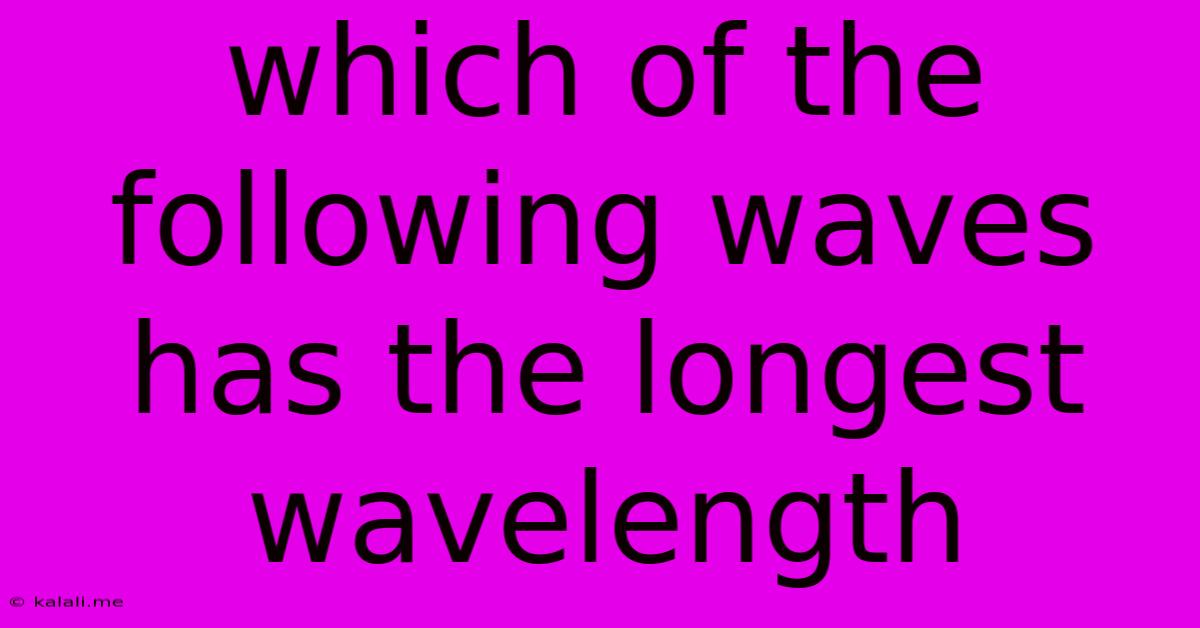Which Of The Following Waves Has The Longest Wavelength
Kalali
Jun 15, 2025 · 3 min read

Table of Contents
Which of the Following Waves Has the Longest Wavelength? A Deep Dive into the Electromagnetic Spectrum
This article explores the relationship between wavelength and the different types of electromagnetic waves. We'll examine the electromagnetic spectrum and determine which wave type boasts the longest wavelength. Understanding this is crucial for various fields, from astronomy to telecommunications. By the end, you’ll have a clear grasp of the spectrum and the factors influencing wavelength.
The electromagnetic spectrum encompasses a broad range of electromagnetic radiation, each characterized by its unique wavelength and frequency. These waves, all traveling at the speed of light, differ significantly in their properties and applications. This spectrum includes radio waves, microwaves, infrared radiation, visible light, ultraviolet radiation, X-rays, and gamma rays.
Understanding Wavelength and Frequency
Before diving into specific wave types, it's important to understand the inverse relationship between wavelength and frequency. Wavelength (λ) is the distance between two consecutive crests or troughs of a wave. Frequency (f) represents the number of wave cycles passing a given point per unit of time. The speed of light (c) remains constant, and the relationship is expressed as:
c = λf
This means that as the wavelength increases, the frequency decreases, and vice versa.
Comparing Wavelengths Across the Electromagnetic Spectrum
Now, let's compare the wavelengths of the different types of electromagnetic waves:
-
Radio Waves: These waves have the longest wavelengths, ranging from millimeters to kilometers. They are used extensively in broadcasting, communication, and radar systems. Their low frequency allows for long-distance transmission.
-
Microwaves: Shorter than radio waves, microwaves have wavelengths ranging from millimeters to centimeters. They find applications in cooking, communication (satellite communication, for example), and radar.
-
Infrared Radiation: Infrared waves have wavelengths shorter than microwaves, typically ranging from micrometers to millimeters. We experience infrared radiation as heat; it's emitted by all objects with a temperature above absolute zero.
-
Visible Light: This is the portion of the electromagnetic spectrum we can see, with wavelengths ranging from approximately 400 to 700 nanometers. The different wavelengths within this range correspond to different colors, from violet (shortest wavelength) to red (longest wavelength within visible light).
-
Ultraviolet Radiation: UV radiation has shorter wavelengths than visible light, ranging from 10 to 400 nanometers. It's responsible for sunburns and has applications in sterilization and fluorescence.
-
X-rays: X-rays possess even shorter wavelengths, typically ranging from 0.01 to 10 nanometers. Their high energy allows them to penetrate soft tissues, making them valuable in medical imaging.
-
Gamma Rays: These are the waves with the shortest wavelengths in the electromagnetic spectrum, ranging from less than 0.01 nanometers to less than a picometer. They are highly energetic and are emitted by radioactive materials and during nuclear reactions.
Conclusion: Radio Waves Reign Supreme
In conclusion, radio waves have the longest wavelengths within the electromagnetic spectrum. Their significantly larger wavelengths compared to other types of electromagnetic radiation allow them to travel great distances and penetrate obstacles effectively. This unique property makes them indispensable for various long-range communication technologies.
Latest Posts
Latest Posts
-
What Is The Antonym Of Opaque
Jun 15, 2025
-
Freezing Point Of Water In Celsius And Fahrenheit
Jun 15, 2025
-
What Cell Organelle Carries Out Cellular Respiration
Jun 15, 2025
-
Which Game Was Invented In India
Jun 15, 2025
-
Which Of The Following Is A First Class Lever
Jun 15, 2025
Related Post
Thank you for visiting our website which covers about Which Of The Following Waves Has The Longest Wavelength . We hope the information provided has been useful to you. Feel free to contact us if you have any questions or need further assistance. See you next time and don't miss to bookmark.